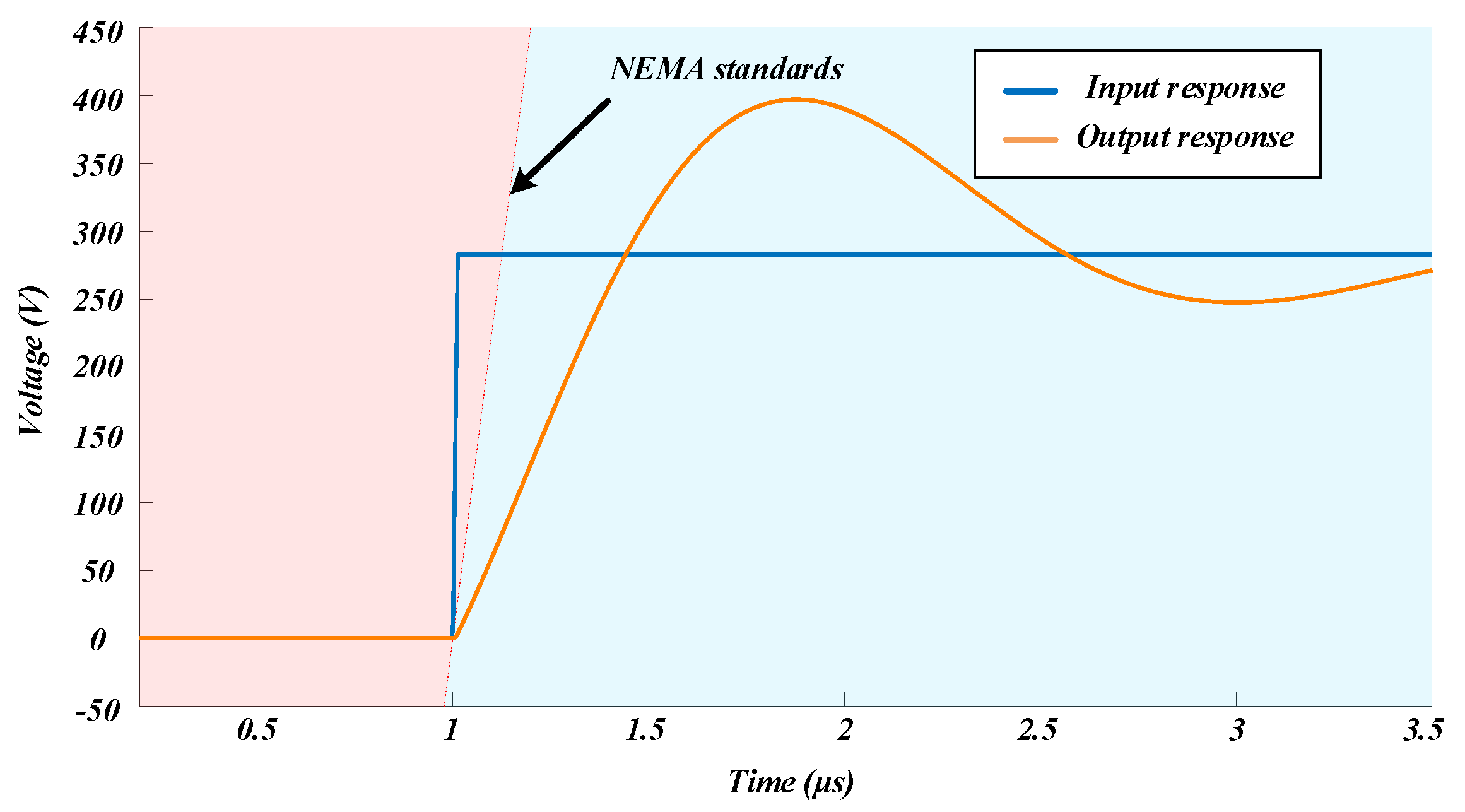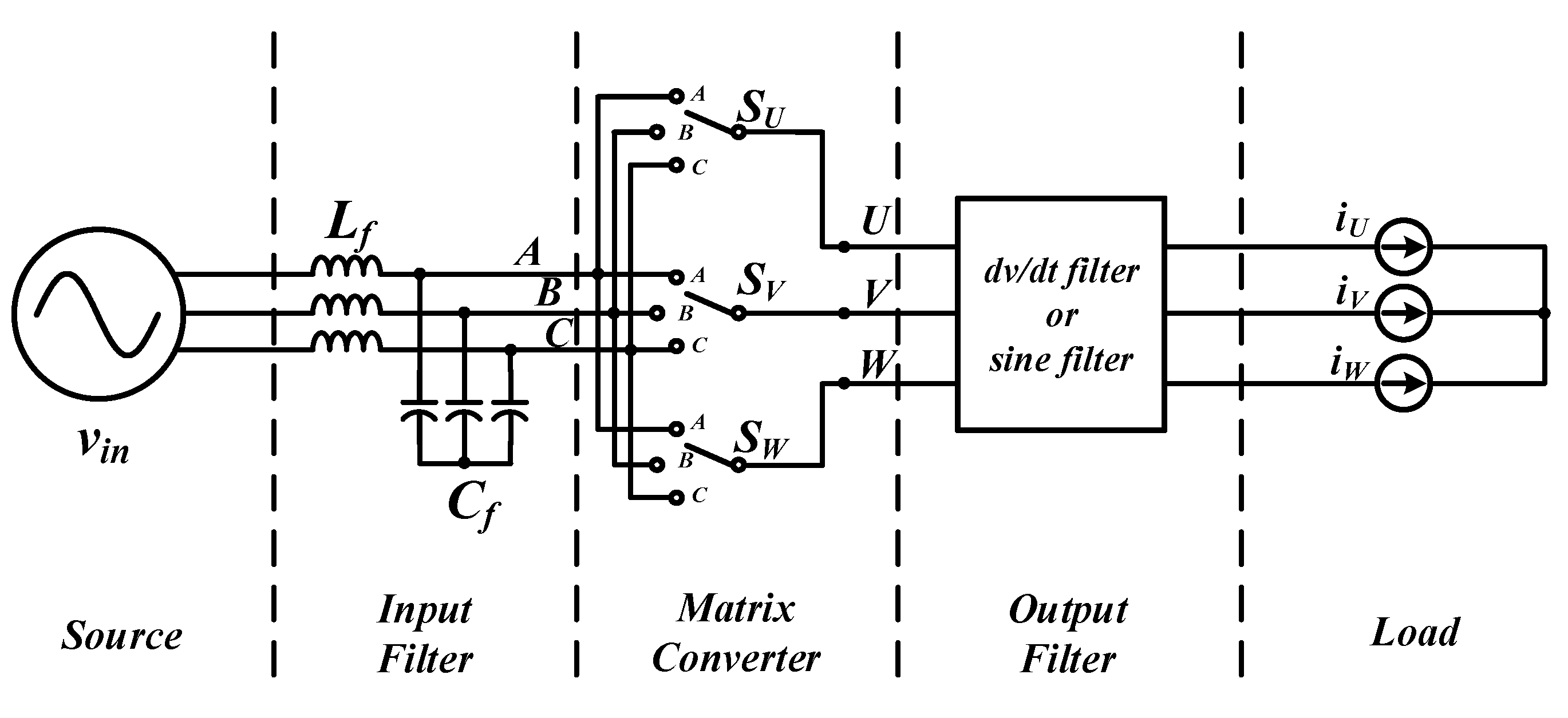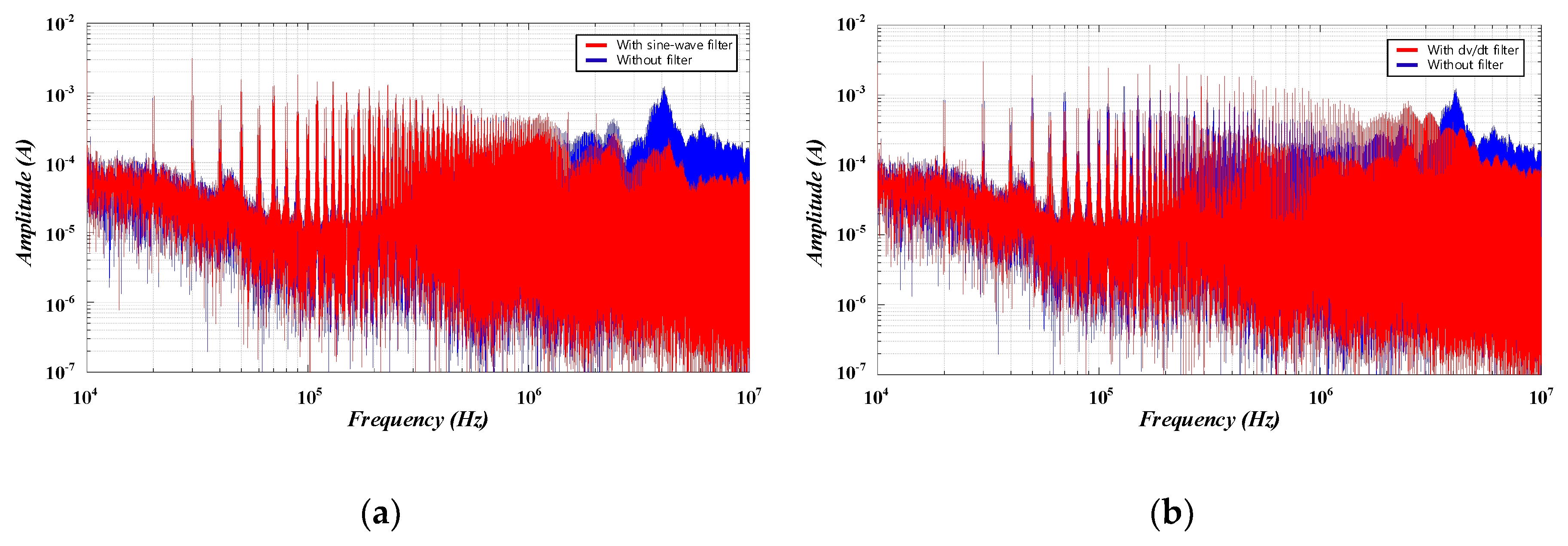GaN-based Matrix Converter Design with Output Filters for Motor Friendly Drive System
Abstract
:1. Introduction
2. Design and Practical Implementation for GaN-Based Power System
2.1. Design of Gate Driver Circuit
2.2. Design of PCB Layout
2.3. Estimation of Parasitic Inductance
3. Output Filter Design
4. Experimental Results
4.1. Switching Performance
4.2. Output Filter Experiments
5. Conclusions
Author Contributions
Funding
Conflicts of Interest
References
- Chen, K.J.; Häberlen, O.; Lidow, A.; Lin Tsai, C.; Ueda, T.; Uemoto, Y.; Wu, Y. GaN-on-Si Power Technology: Devices and Applications. IEEE Trans. Ind. Electron. 2017, 64, 779–795. [Google Scholar] [CrossRef]
- Jones, E.A.; Wang, F.F.; Costinett, D. Review of Commercial GaN Power Devices and GaN-Based Converter Design Challenges. IEEE Trans. Emerg. Sel. Top. Power Electron. 2016, 4, 707–719. [Google Scholar] [CrossRef]
- Chow, T.P. Wide bandgap semiconductor power devices for energy efficient systems. In Proceedings of the 2015 IEEE 3rd Workshop on Wide Bandgap Power Devices and Applications (WiPDA), Blacksburg, VA, USA, 2–4 November 2015; pp. 402–405. [Google Scholar]
- Lee, W.; Li, S.; Han, D.; Sarlioglu, B.; Minav, T.A.; Pietola, M. A Review of Integrated Motor Drive and Wide-Bandgap Power Electronics for High-Performance Electro-Hydrostatic Actuators. IEEE Trans. Transport. Electrif. 2018, 4, 684–693. [Google Scholar] [CrossRef]
- Morya, A.K.; Gardner, M.C.; Anvari, B.; Liu, L.; Yepes, A.G.; Doval-Gandoy, J.; Toliyat, H.A. Wide Bandgap Devices in AC Electric Drives: Opportunities and Challenges. IEEE Trans. Transport. Electrif. 2019, 5, 3–20. [Google Scholar] [CrossRef]
- Wang, J.; Li, Y.; Han, Y. Integrated Modular Motor Drive Design with GaN Power FETs. IEEE Trans. Ind. Appl. 2015, 51, 3198–3207. [Google Scholar] [CrossRef]
- Ding, X.; Zhou, Y.; Cheng, J. A review of gallium nitride power device and its applications in motor drive. CES Trans. Electr. Mach. Syst. 2019, 3, 54–64. [Google Scholar] [CrossRef]
- Uğur, M.; Keysan, O. Multi-physics design optimisation of a GaN-based integrated modular motor drive system. J. Eng. 2019, 2019, 3900–3905. [Google Scholar]
- Zhang, Z.; Wang, F.; Tolbert, L.M.; Blalock, B.J.; Costinett, D.J. Evaluation of Switching Performance of SiC Devices in PWM Inverter-Fed Induction Motor Drives. IEEE Trans. Power Electron. 2015, 30, 5701–5711. [Google Scholar] [CrossRef]
- Marzoughi, A.; Burgos, R.; Boroyevich, D. Investigating Impact of Emerging Medium-Voltage SiC MOSFETs on Medium-Voltage High-Power Industrial Motor Drives. IEEE Trans. Emerg. Sel. Top. Power Electron. 2019, 7, 1371–1387. [Google Scholar] [CrossRef]
- Han, Y.; Lu, H.; Li, Y.; Chai, J. Analysis and Suppression of Shaft Voltage in SiC-Based Inverter for Electric Vehicle Applications. IEEE Trans. Power Electron. 2019, 34, 6276–6285. [Google Scholar] [CrossRef]
- Bai, B.; Wang, Y.; Wang, X. Suppression for Discharging Bearing Current in Variable-Frequency Motors Based on Electromagnetic Shielding Slot Wedge. IEEE Trans. Magn. 2015, 51, 1–4. [Google Scholar] [CrossRef]
- Swamy, M.M.; Kang, J.; Shirabe, K. Power Loss, System Efficiency, and Leakage Current Comparison between Si IGBT VFD and SiC FET VFD with Various Filtering Options. IEEE Trans. Ind. Appl. 2015, 3858–3866. [Google Scholar] [CrossRef]
- Shirabe, K.; Swamy, M.M.; Kang, J.; Hisatsune, M.; Wu, Y.; Kebort, D.; Honea, J. Efficiency Comparison Between Si-IGBT-Based Drive and GaN-Based Drive. IEEE Trans. Ind. Appl. 2014, 50, 566–572. [Google Scholar] [CrossRef]
- Gong, X.; Ferreira, J.A. Comparison and Reduction of Conducted EMI in SiC JFET and Si IGBT-Based Motor Drives. IEEE Trans. Power Electron. 2014, 50, 1757–1767. [Google Scholar] [CrossRef]
- Baek, S.; Cho, Y.; Cho, B.; Hong, C. Performance Comparison between Two-Level and Three-Level SiC-Based VFD Applications with Output Filters. IEEE Trans. Ind. Appl. 2019, 55, 4770–4779. [Google Scholar] [CrossRef]
- Ala, G.; Giaconia, G.C.; Giglia, G.; Piazza, M.C.D.; Vitale, G. Design and Performance Evaluation of a High Power-Density EMI Filter for PWM Inverter-Fed Induction-Motor Drives. IEEE Trans. Ind. Appl. 2016, 52, 2397–2404. [Google Scholar] [CrossRef] [Green Version]
- Wang, S.; Maillet, Y.Y.; Wang, F.; Boroyevich, D.; Burgos, R. Investigation of Hybrid EMI Filters for Common-Mode EMI Suppression in a Motor Drive System. IEEE Trans. Power Electron. 2010, 25, 1034–1045. [Google Scholar] [CrossRef]
- Akagi, H.; Shimizu, T. Attenuation of Conducted EMI Emissions from an Inverter-Driven Motor. IEEE Trans. Power Electron. 2008, 23, 282–290. [Google Scholar] [CrossRef]
- Akagi, H.; Tamura, S. A Passive EMI Filter for Eliminating Both Bearing Current and Ground Leakage Current From an Inverter-Driven Motor. IEEE Trans. Power Electron. 2006, 21, 1459–1469. [Google Scholar] [CrossRef]
- Han, D.; Li, S.; Wu, Y.; Choi, W.; Sarlioglu, B. Comparative Analysis on Conducted CM EMI Emission of Motor Drives: WBG Versus Si Devices. IEEE Trans. Ind. Electron. 2017, 64, 8353–8363. [Google Scholar] [CrossRef]
- Kim, H.; Acharya, S.; Anurag, A.; Kim, B.; Bhattacharya, S. Effect of Inverter Output dv/dt with Respect to Gate Resistance and Loss Comparison with dv/dt Filters for SiC MOSFET based High Speed Machine Drive Applications. In Proceedings of the 2019 IEEE Energy Conversion Congress and Exposition (ECCE), Baltimore, MD, USA, 29 September–3 October 2019; pp. 2301–2306. [Google Scholar]
- Kim, H.; Kim, B.; Bhattacharya, S. An Analytical Design Strategy and Implementation of a Dv/Dt Filter for WBG Devices Based High Speed Machine Drives. In Proceedings of the IECON 2018-44th Annual Conference of the IEEE Industrial Electronics Society, Washington, DC, USA, 21–23 October 2018; pp. 385–390. [Google Scholar]
- Stubenrauch, F.; Seliger, N.; Schmitt-Landsiedel, D. Design and Performance of a 200 kHz GaN Motor Inverter with Sine Wave Filter. In Proceedings of the PCIM Europe 2017; International Exhibition and Conference for Power Electronics, Intelligent Motion, Renewable Energy and Energy Management, Nuremberg, Germany, 16–18 May 2017; pp. 1–9. [Google Scholar]
- Müller, J.; Manthey, T.; Han, D.; Sarlioglu, B.; Friebe, J.; Mertens, A. Output Sine-Wave Filter Design and Characterization for a 10 kW SiC Inverter. In Proceedings of the 2019 IEEE Energy Conversion Congress and Exposition (ECCE), Baltimore, MD, USA, 29 September–3 October 2019; pp. 359–366. [Google Scholar]
- Maislinger, F.; Ertl, H.; Stojcic, G.; Holzner, F. Efficiency and Motor-Performance Improvement Using WBG-Inverters with Observer-based Actively Damped LC-Sine Wave Filters. In Proceedings of the PCIM Europe 2019; International Exhibition and Conference for Power Electronics, Intelligent Motion, Renewable Energy and Energy Management, Nuremberg, Germany, 7–9 May 2019; pp. 1–9. [Google Scholar]
- Maislinger, F.; Ertl, H.; Stojcic, G.; Lagler, C.; Holzner, F. Design of a 100 kHz wide bandgap inverter for motor applications with active damped sine wave filter. J. Eng. 2019, 17, 3766–3771. [Google Scholar] [CrossRef]
- Yuen, K.K.; Chung, H.S. A Low-Loss “RL-Plus-C” Filter for Overvoltage Suppression in Inverter-Fed Drive System With Long Motor Cable. IEEE Trans. Power Electron. 2015, 30, 2167–2181. [Google Scholar] [CrossRef]
- Velander, E.; Bohlin, G.; Sandberg, Å.; Wiik, T.; Botling, F.; Lindahl, M.; Zanuso, G.; Nee, H. An Ultralow Loss Inductorless $dv/dt$ Filter Concept for Medium-Power Voltage Source Motor Drive Converters with SiC Devices. IEEE Trans. Power Electron. 2018, 33, 6072–6081. [Google Scholar] [CrossRef]
- Schroedermeier, A.; Ludois, D.C. Integration of Inductors, Capacitors, and Damping into Bus Bars for Silicon Carbide Inverter dv/dt Filters. IEEE Trans. Ind. Appl. 2019, 55, 5045–5054. [Google Scholar] [CrossRef]
- He, J.; Li, C.; Jassal, A.; Thiagarajan, N.; Zhang, Y.; Prabhakaran, S.; Feliz, C.; Graham, J.; Kang, X. Multi-Domain Design Optimization of dv/dt Filter for SiC-Based Three-Phase Inverters in High-Frequency Motor-Drive Applications. IEEE Trans. Ind. Appl. 2019, 55, 5215–5222. [Google Scholar] [CrossRef]
- Ruffo, R.; Guglielmi, P.; Armando, E. Inverter Side RL Filter Precise Design for Motor Overvoltage Mitigation in SiC-Based Drives. IEEE Trans. Ind. Electron. 2020, 67, 863–873. [Google Scholar] [CrossRef]
- Kamruzzaman, M.; Barzegaran, M.R.; Mohammed, O.A. EMI Reduction of PMSM Drive through Matrix Converter Controlled With Wide-Bandgap Switches. IEEE Trans. Magn. 2017, 53, 1–4. [Google Scholar] [CrossRef]
- Ellabban, O.; Abu-Rub, H.; Ge, B. A Quasi-Z-Source Direct Matrix Converter Feeding a Vector Controlled Induction Motor Drive. IEEE Trans. Emerg. Sel. Top. Power Electron. 2015, 3, 339–348. [Google Scholar] [CrossRef]
- Metidji, B.; Taib, N.; Baghli, L.; Rekioua, T.; Bacha, S. Phase Current Reconstruction Using a Single Current Sensor of Three-Phase AC Motors Fed by SVM-Controlled Direct Matrix Converters. IEEE Trans. Ind. Electron. 2013, 60, 5497–5505. [Google Scholar] [CrossRef]
- Siami, M.; Khaburi, D.A.; Rivera, M.; Rodríguez, J. A Computationally Efficient Lookup Table Based FCS-MPC for PMSM Drives Fed by Matrix Converters. IEEE Trans. Ind. Electron. 2017, 64, 7645–7654. [Google Scholar] [CrossRef]
- Siami, M.; Khaburi, D.A.; Rodriguez, J. Simplified Finite Control Set-Model Predictive Control for Matrix Converter-Fed PMSM Drives. IEEE Trans. Power Electron. 2018, 33, 2438–2446. [Google Scholar] [CrossRef]
- Xia, C.; Zhao, J.; Yan, Y.; Shi, T. A Novel Direct Torque Control of Matrix Converter-Fed PMSM Drives Using Duty Cycle Control for Torque Ripple Reduction. IEEE Trans. Ind. Electron. 2014, 61, 2700–2713. [Google Scholar] [CrossRef]
- Hirota, T.; Inomata, K.; Yoshimi, D.; Higuchi, M. Nine Switches Matrix Converter Using Bi-directional GaN Device. In Proceedings of the 2018 International Power Electronics Conference (IPEC-Niigata 2018-ECCE Asia), Niigata, Japan, 20–24 May 2018; pp. 3952–3957. [Google Scholar]
- Meng, W.; Zhang, F.; Fu, Z.; Dong, G. High dv/dt Noise Modeling and Reduction on Control Circuits of GaN-Based Full Bridge Inverters. IEEE Trans. Power Electron. 2019, 34, 12246–12261. [Google Scholar] [CrossRef]
- GN001 Application Guide Design with GaN Enhanment Mode HEMT. Available online: https://gansystems.com/wpcontent/uploads/2018/04/GN001Design_with_GaN_EHEMT_180412.pdf (accessed on 12 April 2018).
- Haryani, N.; Zhang, X.; Burgos, R.; Boroyevich, D. Static and dynamic characterization of GaN HEMT with low inductance vertical phase leg design for high frequency high power applications. In Proceedings of the 2016 IEEE Applied Power Electronics Conference and Exposition (APEC), Long Beach, CA, USA, 20–24 March 2016; pp. 1024–1031. [Google Scholar]
- NEMA Standards Publication MG 1-2009. Available online: https://law.resource.org/pub/us/cfr/ibr/005/nema.mg-1.2009.pdf (accessed on 19 May 2009).
- GS66508P 650V Enhancement Mode GaN Transistor Preliminary Datasheet. Available online: http://www.gansystems.com/datasheets/20150904/GS66508P%20DS%20Rev%20151016.pdf (accessed on 16 October 2015).














| Vrated | Vpeak | Trise |
|---|---|---|
| Vrated < 600 V | Vpeak < 3.1·Vrated | Trise > 0.1 μs |
| Vrated > 600 V | Vpeak < 2.04·Vrated | Trise > 1 μs |
| Parameter | dv/dt Filter | Sine-Wave Filter |
|---|---|---|
| Filter inductance | 48 μH | 250 μH |
| Filter capacitance | 2.35 nF | 10 μF |
| Damping resistance | 100 Ω | None |
| Cutoff frequency | 4.74 MHz | 3.18 kHz |
| Parameters | Value |
|---|---|
| Input voltage (line-to-line) | 200 Vrms (3-phase) |
| Input frequency | 60 Hz |
| Voltage transfer ratio (VTR) | 0.7 |
| Output frequency | 60 Hz |
| Switching frequency | 10 kHz |
| Maximum power | 1 kVA |
© 2020 by the authors. Licensee MDPI, Basel, Switzerland. This article is an open access article distributed under the terms and conditions of the Creative Commons Attribution (CC BY) license (http://creativecommons.org/licenses/by/4.0/).
Share and Cite
Bu, H.; Cho, Y. GaN-based Matrix Converter Design with Output Filters for Motor Friendly Drive System. Energies 2020, 13, 971. https://doi.org/10.3390/en13040971
Bu H, Cho Y. GaN-based Matrix Converter Design with Output Filters for Motor Friendly Drive System. Energies. 2020; 13(4):971. https://doi.org/10.3390/en13040971
Chicago/Turabian StyleBu, Hanyoung, and Younghoon Cho. 2020. "GaN-based Matrix Converter Design with Output Filters for Motor Friendly Drive System" Energies 13, no. 4: 971. https://doi.org/10.3390/en13040971
APA StyleBu, H., & Cho, Y. (2020). GaN-based Matrix Converter Design with Output Filters for Motor Friendly Drive System. Energies, 13(4), 971. https://doi.org/10.3390/en13040971





